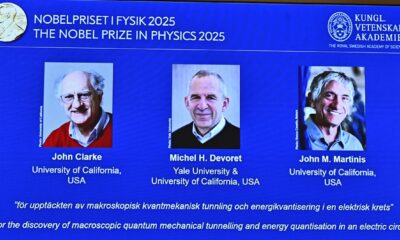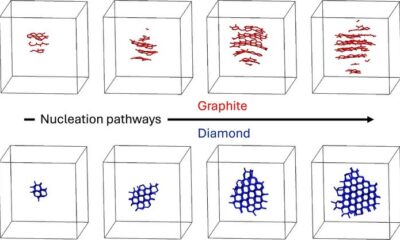Science
Quantum Computing Advances: Error Correction and Market Growth

Innovations in quantum computing are accelerating, particularly in the areas of error correction and algorithm development. Experts from various organizations, including IBM and Riverlane, are racing to create a fault-tolerant quantum computer, a significant milestone that could revolutionize computational capabilities. Currently, the challenge lies in managing errors that arise from the inherently fragile nature of qubits, which are essential for quantum computation.
To achieve a functional universal quantum computer, researchers need to entangle millions of coherent qubits. However, environmental factors such as temperature fluctuations and interference from surrounding electronic systems often lead to errors. These errors cannot be corrected simply by duplicating qubit states, as the principles of quantum mechanics prevent copying entangled states. As a result, addressing quantum error correction (QEC) is crucial for the future viability of quantum technology.
Understanding Quantum Error Correction
The fundamental principle of QEC involves distributing information across multiple qubits so that errors in individual qubits do not significantly compromise the overall system. John Preskill, the director of the Institute for Quantum Information and Matter at the California Institute of Technology, states that a highly entangled state is necessary to protect quantum systems from damage.
Various methods exist for achieving this distribution, often influenced by the physical architecture of the quantum system. Michael Cuthbert, founding director of the UK’s National Quantum Computing Centre (NQCC), emphasizes that error correction mechanisms must operate at speeds comparable to gate operations. “There’s no point in doing a gate operation in a nanosecond if it takes 100 microseconds to do the error correction for the next gate operation,” he noted.
Currently, efforts to manage errors focus more on compensation than correction. Techniques such as post-selection, which involves discarding unreliable results, are commonplace. Additionally, enhancing the design of qubits to be less error-prone is an ongoing area of research.
Progress and Future Prospects
To safeguard the information stored in qubits, multiple unreliable physical qubits must be combined. This approach allows the system to remain functional even if one qubit fails. As Maria Maragkou, commercial vice-president of Riverlane, explains, the transition to support error correction has major implications for both hardware design and operational workflows.
With advancements in QEC, the goal is to manage errors effectively during computations. Researchers at Google recently reported that their 105-qubit Willow quantum chip surpassed a critical threshold, where the error rate diminishes as more physical qubits are added. This achievement indicates the potential for scaling quantum systems without the risk of error accumulation.
According to Jay Gambetta, director of IBM research, the key to transformative quantum calculations lies in the capacity to operate with arrays of at least 100 logical qubits. “The number of operations is the most important thing,” he asserts, expressing confidence that IBM will meet these benchmarks by 2029.
Some industry leaders, including Steve Brierly, chief executive of Riverlane, believe the first error-corrected quantum computer could emerge as early as 2027, utilizing around 10,000 physical qubits to support 100 logical qubits. This machine would be capable of performing a million quantum operations (a megaQuOp).
As the quantum computing landscape evolves, the development of software that maximizes the unique properties of quantum mechanics becomes imperative. Currently, users must often engage with complex quantum physics to achieve optimal performance. However, advancements aim to create platform-independent software that abstracts away these complexities.
While there remains skepticism about the commercial demand for individual quantum machines, early adopters are expected to leverage cloud-based quantum resources for specific applications. This hybrid model, combining quantum and classical computing, is anticipated to yield significant advancements in fields such as quantum chemistry and materials science.
In collaboration with Japan’s national research laboratory RIKEN, IBM has initiated efforts to integrate quantum computing with classical supercomputing. This partnership showcases the potential for quantum-centric solutions to tackle complex scientific problems. For instance, researchers recently utilized a hybrid approach to calculate the minimum energy state of a complex iron-sulphide cluster, an essential component of nitrogen-fixing enzymes.
As experts continue to refine quantum error correction and develop robust algorithms, the future holds promise for a variety of commercial applications. In addition to optimizing processes in energy networks, quantum computing may provide solutions for simulating new materials vital for clean energy technology.
The ongoing progress in quantum computing reflects a rapidly evolving field poised for significant breakthroughs. As organizations strive to bridge the gap between theoretical promise and practical application, the emergence of user-friendly quantum systems remains a critical goal. The journey ahead will require collaborative efforts across disciplines to realize the full potential of quantum technologies.
-

 World3 days ago
World3 days agoCoronation Street’s Shocking Murder Twist Reveals Family Secrets
-

 Entertainment4 months ago
Entertainment4 months agoKate Garraway Sells £2 Million Home Amid Financial Struggles
-

 Entertainment3 months ago
Entertainment3 months agoAnn Ming Reflects on ITV’s ‘I Fought the Law’ Drama
-

 Health3 months ago
Health3 months agoKatie Price Faces New Health Concerns After Cancer Symptoms Resurface
-

 Entertainment3 weeks ago
Entertainment3 weeks agoCoronation Street Fans React as Todd Faces Heartbreaking Choice
-

 World4 weeks ago
World4 weeks agoBailey Announces Heartbreaking Split from Rebecca After Reunion
-

 Entertainment6 days ago
Entertainment6 days agoTwo Stars Evicted from I’m A Celebrity Just Days Before Finale
-

 World6 days ago
World6 days agoKevin Sinfield Exceeds Fundraising Goal Ahead of Final Marathons
-

 Entertainment3 months ago
Entertainment3 months agoCoronation Street’s Carl Webster Faces Trouble with New Affairs
-

 Entertainment3 months ago
Entertainment3 months agoWhere is Tinder Swindler Simon Leviev? Latest Updates Revealed
-

 Entertainment4 months ago
Entertainment4 months agoMarkiplier Addresses AI Controversy During Livestream Response
-

 Science2 months ago
Science2 months agoBrian Cox Addresses Claims of Alien Probe in 3I/ATLAS Discovery



















